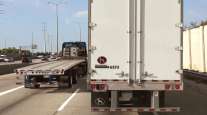Highway Fatality Rate Falls Again
This story appears in the April 18 print edition of Transport Topics. Click here to subscribe today.
The rate at which fatalities occurred in highway accidents involving large trucks dropped to the lowest level on record, falling 14.1% in 2009 from the previous year, according to an analysis of Department of Transportation data by American Trucking Associations.
The number of people killed in truck-involved crashes fell to 1.17 per 100 million miles traveled during 2009, down from 1.37 in 2008, ATA said last week. It was the lowest level since the National Highway Traffic Safety Administration and Federal Highway Administration began compiling this data in 1975.
The data are the latest available from the federal government and are delayed by the process of measuring the number of miles driven on U.S. roads and collecting fatality statistics from all 50 states.
NHTSA reported a record low 3,380 fatalities, including 503 truck drivers, in 2,987 crashes involving trucks weighing more than 10,000 pounds in 2009. In 2008, there were 4,245 fatalities, including 682 truck drivers, in 3,754 crashes. FHWA calculated that trucks traveled 288 billion miles in 2009, a decline of 7.4% from 311 billion miles in 2008.
“This is great news, not just for the trucking industry, but for the entire motoring public,” ATA President Bill Graves said. “These improvements are testament to the commitment to safety made by the trucking industry, the federal government and trucking’s law enforcement partners.”
The decline in the fatality rate was the fifth in a row and the ninth in the past decade, with the only increase occurring in 2004.
The highest recorded truck-involved fatality rate was in 1979 with 6.15 deaths per 100 million miles traveled.
ATA last week called for the Federal Motor Carrier Safety Administration to drop its proposed changes in driver hours-of-service limits, arguing that the lower fatalities rate was achieved under the existing regulation, which went into effect in 2004.
“Since FMCSA began its effort to revise these rules, we have said the current rules are working. The Obama administration’s own data now supports that belief,” Graves said. “Since the agency first changed the hours rules in 2004, the truck-involved fatality rate has dropped by 36% — nearly twice as fast as the overall fatality rate on our highways — and that’s not a coincidence: The current rules are working.”
“In fact, the 2004 hours-of-service rule change is the one and only significant truck safety regulatory improvement made by FMCSA between 2004 and 2009,” Graves added.
According to NHTSA, the fatality rate for all vehicles — passenger cars, buses, light trucks and motorcycles — also fell, dropping to 1.13 per 100 million miles traveled in 2009 from 1.26 in 2008. The agency projected a further drop in the overall fatality rate to 1.09 per 100 million miles traveled for 2010.
In a revision affecting prior years’ data, FHWA raised its estimate of truck miles travelled since 2000, using new data on truck registrations to estimate the number and type of vehicles in use and eliminating a “data-smoothing technique” for traffic data supplied by states.
Advancements in data collection have improved the accuracy of traffic information and have made the use of data-smoothing methods, in which actual reports are averaged with past data, “no longer appropriate,” said Patrick Zhang, a researcher for FHWA’s Office of Highway Policy Information.
The new estimates better “reflect the rapid change in economic conditions and goods and passenger travel patterns,” Zhang said.
Henry Jasny, general counsel for Advocates for Highway & Auto Safety in Washington, D.C., said fatality rates have been dropping for a long time but the number of fatalities has only recently begun to fall.
“A lot of it has to do with the downturn,” Jasny said. “As the economy picks up, the question is will we see a return to higher numbers? We hope not.”
Daniel Blower, director of the Center for National Truck and Bus Statistics at the University of Michigan, said the recession and high fuel costs may have kept more bad drivers off the road, reducing the risk of car-truck crashes.
Trucking companies also may have used the downturn in business to eliminate their worst-performing drivers.
“If I’m a trucking company and need to cut back, I’m going to try to keep my best, most experienced drivers,” Blower said. “And, I’m going to do whatever I can to reduce operating costs, including driving more slowly.”
IIHS recently asked NHTSA to require stronger underride guards to protect occupants of vehicles that crash into the back of semi-trailers.
“I’m not optimistic that the government is going to take quick action,” Rader said in an interview with Transport Topics. “We got a very positive reaction from ATA, and I think we can work with the industry to make voluntary changes.”
NHTSA estimates that about 423 people die each year in trailer underride crashes.
Graves said the amount of safety improvement as measured by the drop in the fatality rate was “significant,” and he said ATA would work to achieve additional gains by encouraging companies to limit the maximum speed of trucks on the road and by advocating for tax incentives to encourage voluntary adoption of safety-rated technologies.
“Dedication to safety is a core value of ATA and the trucking industry,” said ATA Chairman Barbara Windsor, president of Hahn Transportation, New Market, Md. “We’ve expressed that with our 18-point progressive safety agenda and programs like Share the Road and America’s Road Team. These figures are the fruits of those efforts.”




